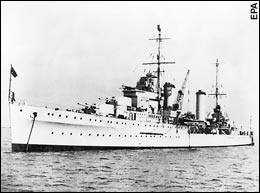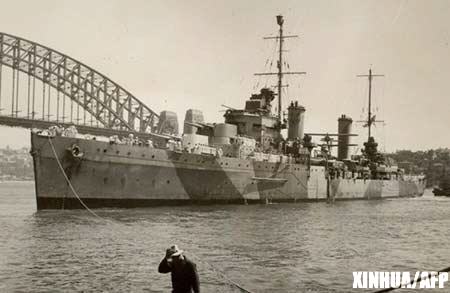lia’s most intriguing wartime mystery has been solved with the discovery of the wreckage of the battleship HMAS Sydney.
HMAS Sydney found off Australia’s west coast
The Sydney, a cruiser, was the biggest ship from any country to be sunk with all hands lost during World War II.
It was sunk by the Kormoran, a German naval raider disguised as a Dutch merchant ship, during a fierce battle in the Indian Ocean, off the coast of Western Australia, in November 1941.
The Sydney went down with all 645 men on board - the greatest loss of life from an Australian warship.
The fate of HMAS Sydney, and why none of its crew survived the battle, was “Australia’s major maritime mystery” and “unresolved business” said the chief of the Australian navy, Vice Admiral Russ Shalders.
Finding its wreck would enable researchers to “find out why the battle turned out the way it did.”
In the 70 years that the ship’s fate remained a mystery, conspiracy theories have flourished.
Sonar image of German merchant raider Kormoran, wreckage has been found off the Western Australian coast
It has been claimed survivors were machine gunned in the water by the crew of the Kormoran, or that the ship was in fact sunk by a Japanese submarine in an encounter covered up by the Australian government.
It was last seen limping over the horizon, black smoke streaming from its hull and decks, by the crew of the Kormoran.
The German ship, badly damaged during the exchange, also sank but most of its crew of 397 survived and were able to give accounts of what had happened.
After years of failed attempts and bogus discovery claims, a government-funded search expedition, the Finding Sydney Foundation, located the wreckage of the Kormoran 500 miles north of Perth on Saturday.
It was the breakthrough researchers needed in finding the Sydney. Scanning the seabed with sophisticated sonar equipment, they found scattered debris which eventually led them to the final resting place of the cruiser.
“We’ve been working on this for 10, 15 years. It’s been like climbing Mount Everest and now we’re gleefully sliding down the mountain on our backsides,” said the foundation’s Bob Trotter.
Former lieutenant commander Ean McDonald, who served on board the Sydney as a signalman in the early years of the war, said the discovery was very exciting.
“If this really is the Sydney then of course it’s a momentous piece of news. For 66 years it’s been one of the world’s great wartime mysteries. This will bring closure to the families and thousands of descendants of Sydney men.”
In announcing the discovery of the Kormoran at the weekend, prime minister Kevin Rudd said: “All of us concerned about this great ship [the Sydney] and those of us who are concerned about what happened to the 645 brave souls who went down with her, have all these years been wondering where she lay and what in the end actually happened.”
The search was led by American shipwreck hunter David Mearns, who found the wrecks of the British battle cruiser HMS Hood, and the Bismarck, the German battle ship that sank her in the North Atlantic in 1941.
The Sydney is likely to be left on the seabed as a mass war grave.




